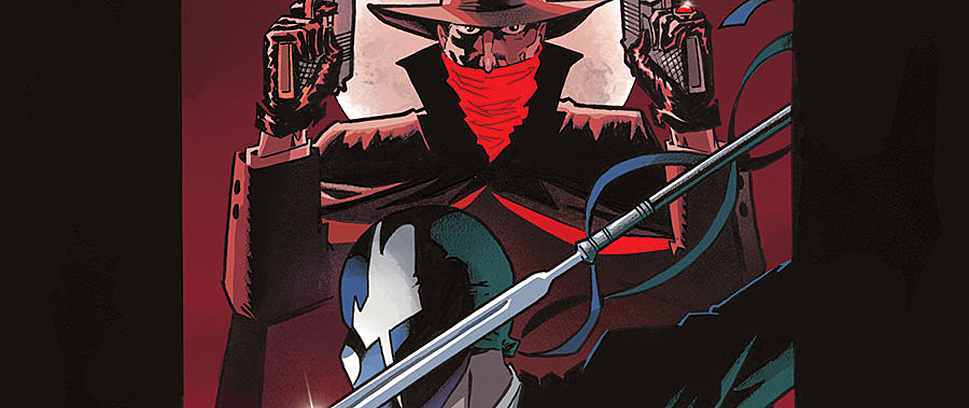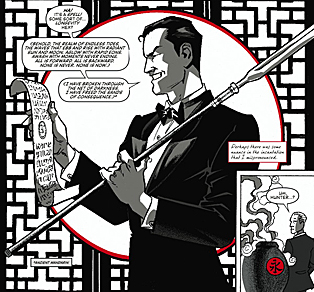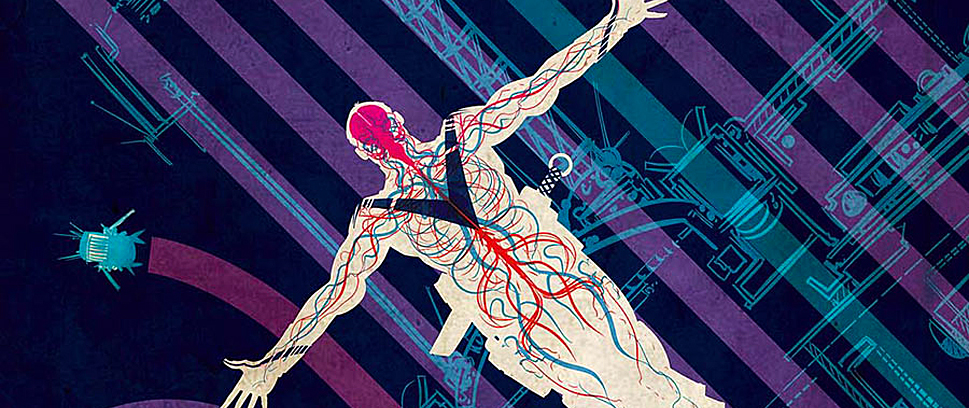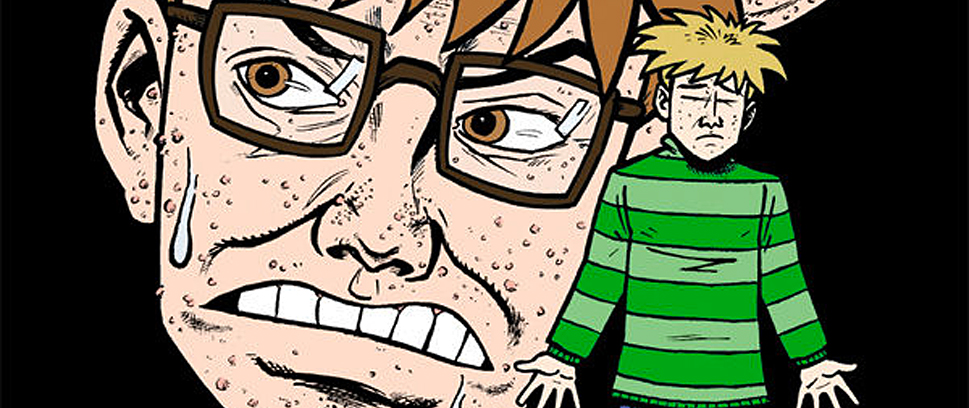
Last Week’s Comics 9/3/2014
Grendel vs. The Shadow #1
(Dark Horse and Dynamite – writer: Matt Wagner; art: Matt Wagner)
The first time I came across Hunter Rose was in the page of Batman/Grendel: Devil’s Riddle. It was the same year as Spectacular Spider-Man #200, Scott McCloud’s Understanding Comics and Batman #500. Since Bruce Wayne wasn’t Batman in his own book, there were only two Batman comics for me: The Batman Adventures and Batman/Grendel. Before then, I’d heard whispers of Grendel in the comic shop but never read an actual Grendel comic.
 I was immediately taken by Matt Wagner’s style. His shadows loomed large. His Batman reminded me of Dave Mazzucchelli’s work in Batman: Year One. Hunter Rose was equally smarmy and lithe. Ever since I read that comic, I’d become fascinated with Hunter Rose. He is an incredibly complicated character. Hunter Rose is a writer. Grendel is a vicious crime lord/adventurer. Hunter Rose genuinely loved his adopted daughter, Stacy Palumbo. He took care of those close to him. Grendel was a ruthless, aggressive monster who lived for murder.
I was immediately taken by Matt Wagner’s style. His shadows loomed large. His Batman reminded me of Dave Mazzucchelli’s work in Batman: Year One. Hunter Rose was equally smarmy and lithe. Ever since I read that comic, I’d become fascinated with Hunter Rose. He is an incredibly complicated character. Hunter Rose is a writer. Grendel is a vicious crime lord/adventurer. Hunter Rose genuinely loved his adopted daughter, Stacy Palumbo. He took care of those close to him. Grendel was a ruthless, aggressive monster who lived for murder.
It is the latter Hunter Rose we see in Grendel vs. The Shadow #1. The story begins when Hunter Rose reads an ancient enchanted scroll that thrusts him backwards in time to Prohibition-era New York City. At this time, the mysterious gun-toting avenger known as The Shadow is paring the bitter fruit of New York’s five crime families. It feels like both a Grendel story and a Shadow story.
Wagner’s comfort in writing and drawing both of these characters feels effortless. Grendel’s aggression fits perfectly in both 1980s New York as much as it does Depression Era New York. Hunter Rose thrives in this era after only an evening observing the more dastardly elements of New York’s nightlife. Pulling him back in time is a clever plot device. Then again, Matt Wagner is a clever creator.
Hunter Rose is Grendel, so it makes sense that we’d see exposition from his point of view throughout the issue. However, The Shadow is not Lamont Cranston, he is The Shadow. Everything else is just a cover for his war on crime. His true self is a mystery not just to those around him, but to the reader as well. He knows what evil lurks in the hearts of men and has no intention of sharing it. So Wagner instead chooses to use Margo Lane’s perspective on The Shadow. Margo is The Shadow’s most trusted operative as well as his lover. She knows him better than anybody, but she is smart enough to know that she doesn’t know all there is to know about the man who calls himself Lamont Cranston.
Wagner has grown into a much more refined storyteller. Every panel of Grendel vs. The Shadow builds a rich world for these two bloodthirsty characters to feast upon. The first issue is off to a particularly bloody start, and I can’t wait to see the havoc a war between Grendel and The Shadow will cause.
Full disclosure: Dark Horse Comics provided Unwinnable with an advanced review PDF of Grendel vs. The Shadow #1. It hits store shelves today.
———
Wayward #1
 (Image – writer: Jim Zub; art: Steve Cummings)
(Image – writer: Jim Zub; art: Steve Cummings)
Wayward is a comic that attempts to share Japan’s rich supernatural heritage with the rest of the world. The story takes a nod from Buffy the Vampire Slayer in that its heroine is not all that she appears, and very quickly we see that Rori Lane, a half Irish/half Japanese teenager, has some special abilities that make her well suited to transition into the mystical world of Ikebukuro, Japan.
Clearly, Jim Zub wants to get to the good stuff, and that’s why his perfunctory introduction seems out of place. He’s quick to lay out everything we need to know about Rori’s life in the first three pages, and Rori’s reunion with her mother is more a storytelling formality than an attempt to build any type of relationship between the characters. Rori’s mom works several shifts at a job that keeps her from being present, and she’s quickly ditched in favor of the main reason for the comic: mythical monsters.
The shift from narrative to action is jarring, but when Rori encounters a group of human-looking turtle-men (you read that correctly), Wayward finds its direction. The action sequence is carried out with taut, engaging pacing and Rori’s true self is really developed. For as much as Zub tries to make Rori seem out of place in her new home, she comes to life once she begins practicing the latent abilities Zub hinted at earlier in the comic. Like Buffy, she’s confident, powerful, and unafraid. Much is still left unanswered by the end of the first issue, but Zub has provided a solid enough foundation that readers will want to come back for more. I know I do.
While the storytelling stumbles a bit before finding its feet, the one constant is Steve Cummings. Partially Manga inspired, but unique enough to have its own personality, Cummings’ art gives life to Rori’s quirky, curious personality. Many of her introductory illustrations are looks of shock and awe, but the action sequences allow Rori to be more than a confused player in this new game. Cummings’ turtle-men are also expertly illustrated, and the action pops off the page through his clean illustrations and sharp composition. Vibrant colors, provided by John Rauch and Jim Zub, also help with the visuals. The comic is definitely engaging in both its story and its visuals.
For a first issue, Wayward has a few missteps, but most of those can be forgiven. Essays in the back of the comic explain the history from which Wayward draws its inspiration, and if the information provided by Zack Davisson is any indicator, issue #1 has barely scratched the surface of the story Jim Zub intends to tell.
Turtle-men wearing human skin? A girl who can talk to cats? Steve Cummings’ stunning art? Sign me up for a more Wayward because I’m definitely intrigued!
———
Low #2
 (Image – writer: Rick Remender; art: Greg Tocchini)
(Image – writer: Rick Remender; art: Greg Tocchini)
The first issue of Low ended on a dramatic note with Stel and Johl’s children being captured by the villainous Rolan, their familial armor being stolen and the two of them being stranded at the bottom of the Mariana Trench. Issue #2 doesn’t improve upon this darkness in any way, but through Rick Remender’s spectacular writing, the Caine family continues its depressing, heart-wrenching and wholly fantastic story.
Remender jumps the story ahead 10 years to focus on Marik, the foul-mouthed machinist son who stayed behind when the family took its disastrous trip. Now, Marik is a police officer, but he hasn’t fared much better. While his mother still searches for her children and relives their abduction every year on its anniversary, Marik has found a different way to cope with his family breaking up, and it’s anything but admirable. Remender taps into the human need to medicate in order to forget, and Marik’s callousness due to his addiction leads to his unraveling by the end of the issue.
Due to Remender’s writing, the characters are fully fleshed out, and the story is every bit as tragic as it could be. While part of the comic focuses on the present, another part focuses on the past and the final moments that occurred between Stel and John. It’s harrowing and beautiful at the same time. In three pages, Remender forms a palpable and poignant relationship between the husband and wife, so much so that your heart is aching for them when Johl says his final goodbye.
Plus, Greg Tocchini’s art is more discernible this time around. Issue #1 was a bit of visual chaos – not that Tocchini’s style isn’t awesome, but occasionally the world Remender creates isn’t clearly lucid. Issue #2 is a beat cleaner in the composition. A few times, the depth perception of the visual is hindered by Tocchini’s erratic inking of indistinct settings. But he definitely captures the tonal grittiness needed for certain scenes, and the close ups are pieces of art. So where Remender strays in the science fiction territory, Tocchini provides the abstractness of the world in order to convey its unique existence.
Everything about this issue is damn near perfect. People who think comics are just for kids are missing out by not reading this book. Low is a piece of literature, from the haunting sadness of the Caine family, to the theatrical pacing of the story, everything about this comic should be celebrated.
Low is a must read for every lover of comic books.
———
All-New X-Men #31
 (Marvel – writer: Brian Michael Bendis; art: Mahmud Asrar)
(Marvel – writer: Brian Michael Bendis; art: Mahmud Asrar)
Issues #30 and #31 of All-New X-Men seem like a holding pattern. Issue #30 was a pause in the action, where issue #31 seems to put a cap on previous adventures and takes us to the doorway of the “Ultimate Universe” (no pun intended). I especially could use this breather, considering I mainlined some 50-plus issues (between All-New X-Men and Uncanny X-Men) to get caught up and finally be able to read issues as they come out.
X-23 and Angel, both overwhelmed by life in their own ways, take some personal time away from the craziness that was their latest encounter with the future Brotherhood of Evil Mutants. They get to know each other’s human side. And also get it on.
The mellow mood of issue #30 and the slow build of issue #31 could also be to not distract readers from the issue of Charles Xavier’s will over in Uncanny X-Men. These two titles are so intertwined that you really need to be on top of both.
It’s pretty clear that the time-displaced X-Men aren’t going home anytime soon, and as they’re increasingly coming to grips with this, we the readers need to see more of them branching out and less of their navel gazing and pity partying. We get some forward movement, as Jean Grey takes point and suggests the gang goes to the aid of a mutant newly discovering her powers.
Apparently, a young lady introduced only as Carmen has discovered her power set: an interactive time portal in her belly. How is it linked to Tony Stark’s team’s discovery, one the X-Men aren’t even aware of? How is it related to Cerebro being wonky? Are things related to Carmen’s menstrual cycle, as Hank McCoy hypothesizes? Whatever this power is, it is potent, as Carmen freaks out (understandably) and unknowingly shoots some of the X-Men out of the immediate area (in Jean Grey’s case, a few thousand miles away.) So many unanswered questions, I can practically hear Stan Lee’s exhortation to “tune in next month.”
Regular series artist Stuart Immonen is off this issue, but Mahmud Asrar’s art is strong (and similar enough to Stuart Immonen’s), and Marte Gracia has pretty much been the series’ colorist, so the tone and palette are what you expect to see in All-New X-Men. There are two types of lettering, which seem to differentiate our X-world and the Ultimate Universe. I could do without that.
For now, I feel good about the direction All-New X-Men is taking, but I’m a natural pessimist. I don’t know what another tear in the already torn space-time continuum will mean for the young X-Men in the long term. Marvel seems to think only in terms of universe-shattering events, so we’ll see what mess Xavier’s Will and the Ultimate Universe makes of things!
———
Groo vs. Conan #2
 (Dark Horse – writer: Sergio Aragonés and Mark Evanier; art: Sergio Aragonés and Thomas Yeates)
(Dark Horse – writer: Sergio Aragonés and Mark Evanier; art: Sergio Aragonés and Thomas Yeates)
I can admit to being a fan of Mad magazine since the age of seven. “The Usual Gang of Idiots” never failed to amuse me issue to issue with film and TV parodies, as well reliable regular features such as “Spy vs. Spy” and “The Lighter Side Of.” I always loved “A Mad Look At…” and especially those little cartoons – nicknamed “marginals” or “drawn-out dramas” – that were found in the margins and in between panels of every issue. The man responsible for these last two bits of lunacy for over 50 years has been Sergio Aragonés, and he has been directly responsible for me losing brain cells from multiple rereads of many issues of Mad.
Not long after I started reading Mad I discovered Groo the Wanderer. Written and drawn by Aragonés, Groo is about the adventures of a dimwit barbarian named Groo and his intelligent dog Rufferto. Since I was a fan of Conan the Barbarian and of the cartoons of Sergio Aragonés, I was instantly hooked. Every time I think Groo has gone away for good, I’m pleasantly surprised to see a new series on the stand. Recently, I discovered not one but two issues of this new series, and it was Groo versus Conan! My initial reaction was “they haven’t done this yet?”, but right after that I got excited.
Groo vs. Conan #2 continues on the same path as issue one, with Sergio inserting himself into portions of the comic. The parts with Groo and Conan are the result of hallucinations he’s experiencing due to the painkillers they shoot him up with in the hospital, due to a head injury he suffers in the first issue while trying to draw a Groo vs. Conan comic. Sergio has always been one to randomly get meta in his work, and these “real life” sequences refer to a recent back injury he suffered. While on painkillers, he imagines a ridiculous story where Conan stumbles onto one of Groo’s adventures.
While the Groo portion is drawn in that reliable Sergio Aragonés style, the Conan side is drawn in a style more typical to that character by Thomas Yeates. Yeates’ style reminds me not only of Conan comics but also the ultra-serious Prince Valiant comic strips. When the two characters meet in this issue, that seriousness makes their sharing panel space that much more of a hilarious visual.
Conan is brought in from his homeworld of Hyboria by villagers from Groo’s world to stop what they describe as a monster that is terrorizing their village. It’s actually Groo, who is duped by some wealthy jerks to pillage in exchange for food. It parallels the Sergio portions of the comic, where he is trying to stop a bunch of corporate fat cats from destroying a beloved local comic book shop in the name of development. While the fantasy hallucination segments are just what the comic promises, the real-life segments are unfortunately where the comic drags.
These portions aren’t terrible, but seeing a stark raving mad caricature of Sergio running around in a hospital gown with his butt hanging out for two issues does start to get old. The Conan and Groo segments are fantastic fun, though, and do comprise most of each issue so far. I guess my problem is that the cuts to “reality” happen right in the middle of a 10-page Groo/Conan segment. Like with a bad flashback sequence from a Lost episode, I just want to stick to the much more fun main story, where they’re fighting The Others or discovering a new hatch. I’m sure Evanier and Aragonés are going to link the stories in a more fluid manner in the next couple of issues of this miniseries, so I’m not worried. But since I’m reviewing this issue alone I have to be honest and say that I’m not on board yet with the segments not taking place in the fantasy realms of Conan and Groo.
Don’t let my quibbles be a deterrent, though – overall, both of these issues of Groo vs. Conan deliver with classic Evanier and Aragonés humor. Many of these gags resonate with me now as much as they did 25 years ago, which may or may not be a problem I should get checked out. Aragonés wonderful cartoon illustrations are as strong as ever, and it’s truly great that this comic legend is still prolific at the age of 76. Fans of Conan, Groo, Mad or simply classic cartoon humor and illustration should check this series out.





